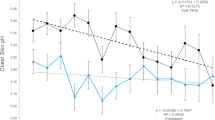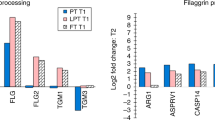Abstract
The skin of neonates and infants exhibits distinct anatomical and functional properties that might be clinically reflected by its characteristic susceptibility to skin barrier disruption. In this systematic review, we aimed to characterize skin barrier maturation as reflected by transepidermal water loss (TEWL) and skin surface pH during the first 2 years of life. We systematically searched MEDLINE and EMBASE via OVID from 1975 to 2013 to identify primary studies reporting TEWL and/or skin surface pH values in healthy full-term infants aged 0–24 months without any cutaneous diseases. After full text assessment, 36 studies reporting n = 8,483 TEWL measurements for 26 anatomical areas and n = 6,437 skin surface pH measurements for 14 anatomical areas were included. The mean age of the subjects ranged from 1.4 h to 1.2 years. The lowest pH of 4.63 was identified on the forehead at the age of 25.6 weeks, whereas the highest of 7.31 was on the volar forearm at 0.0 weeks. The lowest TEWL value of 3.1 g/m2/h was reported for the back at 0.6 weeks and the highest of 43.1 g/m2/h for the upper leg at 58.7 weeks. The skin surface pH reveals a steep decline during the first postnatal week, succeeded by a further gradual site-specific acidification process during the first month. A competent permeability barrier in most anatomical areas is indicated by TEWL, which does not exhibit a time-dependent development during the first 2 years of life.



Similar content being viewed by others
References
Ali SM, Yosipovitch G (2013) Skin pH: from basic science to basic skin care. Acta Derm Venereol 93(3):261–267. doi:10.2340/00015555-1531
Behne MJ, Barry NP, Hanson KM, Aronchik I, Clegg RW, Gratton E, Feingold K, Holleran WM, Elias PM, Mauro TM (2003) Neonatal development of the stratum corneum pH gradient: localization and mechanisms leading to emergence of optimal barrier function. J Invest Dermatol 120(6):998–1006
Berardesca E, Masson P, Rodrigues L, Gummer CL, Lévêque JL, Loden M, Piérard G, Rogiers V, Salter D, Sauermann G, Serup J, Trevethan MA (1997) EEMCO guidance for the assessment of stratum corneum hydration: electrical methods. Skin Res Technol 3(2):126–132
Blume-Peytavi U, Hauser M, Stamatas GN, Pathirana D, Bartels NG (2012) Skin care practices for newborns and infants: review of the clinical evidence for best practices. Pediatr Dermatol 29(1):1–14
Chan A, Mauro T (2011) Acidification in the epidermis and the role of secretory phospholipases. Dermatoendocrinol 3(2):84–90
Chilcott RP, Farrar R (2000) Biophysical measurements of human forearm skin in vivo: effects of site, gender, chirality and time. Skin Res Technol 6(2):64–69
Chiou YB, Blume-Peytavi U (2004) Stratum corneum maturation: a review of neonatal skin function. Skin Pharmacol Physiol 17(2):57–66
Cork MJ, Danby SG, Vasilopoulos Y, Hadgraft J, Lane ME, Moustafa M, Guy RH, Macgowan AL, Tazi-Ahnini R, Ward SJ (2009) Epidermal barrier dysfunction in atopic dermatitis. J Invest Dermatol 129(8):1892–1908. doi:10.1038/jid.2009.133
Crowther JM, Sieg A, Blenkiron P, Marcott C, Matts PJ, Kaczvinsky JR, Rawlings AV (2008) Measuring the effects of topical moisturizers on changes in stratum corneum thickness, water gradients and hydration in vivo. Br J Dermatol 159(3):567–577
Darlenski R, Fluhr JW (2012) Influence of skin type, race, sex, and anatomic location on epidermal barrier function. Clin Dermatol 30(3):269–273. doi:10.1016/j.clindermatol.2011.08.013
De Benedetto A, Kubo A, Beck LA (2012) Skin barrier disruption: a requirement for allergen sensitization. J Invest Dermatol 132(3 Pt 2):949–963
Du Plessis J, Stefaniak A, Eloff F, John S, Agner T, Chou TC, Nixon R, Steiner M, Franken A, Kudla I, Holness L (2013) International guidelines for the in vivo assessment of skin properties in non-clinical settings: Part 2. transepidermal water loss and skin hydration. Skin Res Technol 19(3):265–278. doi:10.1111/srt.12037
Elias PM (2005) Stratum corneum defensive functions: an integrated view. J Invest Dermatol 125(2):183–200. doi:10.1111/j.0022-202X.2005.23668.x
Elias PM (2006) Defensive functions of the stratum corneum: integrative aspects. In: Elias PM, Feingold K (eds) Skin barrier. Taylor & Francis, New York, pp 5–14
Elias PM, Wakefield JS (2011) Therapeutic implications of a barrier-based pathogenesis of atopic dermatitis. Clin Rev Allergy Immunol 41(3):282–295
Elkeeb R, Hui X, Chan H, Tian L, Maibach HI (2010) Correlation of transepidermal water loss with skin barrier properties in vitro: comparison of three evaporimeters. Skin Res Technol 16(1):9–15
Eriksson M, Storm H, Fremming A, Schollin J (2008) Skin conductance compared to a combined behavioural and physiological pain measure in newborn infants. Acta Paediatr 97(1):27–30. doi:10.1111/j.1651-2227.2007.00586.x
Farahmand S, Tien L, Hui X, Maibach HI (2009) Measuring transepidermal water loss: a comparative in vivo study of condenser-chamber, unventilated-chamber and open-chamber systems. Skin Res Technol 15(4):392–398
Flohr C, England K, Radulovic S, McLean WHI, Campbell LE, Barker J, Perkin M, Lack G (2010) Filaggrin loss-of-function mutations are associated with early-onset eczema, eczema severity and transepidermal water loss at 3 months of age. Br J Dermatol 163(6):1333–1336. doi:10.1111/j.1365-2133.2010.10068.x
Fluhr JW, Behne MJ, Brown BE, Moskowitz DG, Selden C, Mao-Qiang M, Mauro TM, Elias PM, Feingold KR (2004) Stratum corneum acidification in neonatal skin: secretory phospholipase A2 and the sodium/hydrogen antiporter-1 acidify neonatal rat stratum corneum. J Invest Dermatol 122(2):320–329. doi:10.1046/j.0022-202X.2003.22204.x
Fluhr JW, Darlenski R, Lachmann N, Baudouin C, Msika P, De Belilovsky C, Hachem JP (2012) Infant epidermal skin physiology: adaptation after birth. Br J Dermatol 166(3):483–490
Fluhr JW, Darlenski R, Taieb A, Hachem J, Baudouin C, Msika P, De Belilovsky C, Berardesca E (2010) Functional skin adaptation in infancy-almost complete but not fully competent. Exp Dermatol 19(6):483–492
Fluhr JW, Dickel H, Kuss O, Weyher I, Diepgen TL, Berardesca E (2002) Impact of anatomical location on barrier recovery, surface pH and stratum corneum hydration after acute barrier disruption. Br J Dermatol 146(5):770–776
Fluhr JW, Feingold KR, Elias PM (2006) Transepidermal water loss reflects permeability barrier status: validation in human and rodent in vivo and ex vivo models. Exp Dermatol 15(7):483–492
Fluhr JW, Mao-Qiang M, Brown BE, Hachem JP, Moskowitz DG, Demerjian M, Haftek M, Serre G, Crumrine D, Mauro TM, Elias PM, Feingold KR (2004) Functional consequences of a neutral pH in neonatal rat stratum corneum. J Invest Dermatol 123(1):140–151
Garcia Bartels N, Massoudy L, Scheufele R, Dietz E, Proquitté H, Wauer R, Bertin C, Serrano J, Blume-Peytavi U (2012) Standardized diaper care regimen: a prospective, randomized pilot study on skin barrier function and epidermal IL-1α in newborns. Pediatr Dermatol 29(3):270–276. doi:10.1111/j.1525-1470.2011.01590.x
Garcia Bartels N, Mleczko A, Schink T, Proquitté H, Wauer RR, Blume-Peytavi U (2009) Influence of bathing or washing on skin barrier function in newborns during the first four weeks of life. Skin Pharmacol Physiol 22(5):248–257
Garcia Bartels N, Rösler S, Martus P, Stroux A, Lönnfors S, Reißhauer A, Blume-Peytavi U (2011) Effect of baby swimming and baby lotion on the skin barrier of infants aged 3–6 months. JDDG J Dtsch Dermatol Ges 9(12):1018–1025. doi:10.1111/j.1610-0387.2011.07710.x
Garcia Bartels N, Scheufele R, Prosch F, Schink T, Proquitté H, Wauer RR, Blume-Peytavi U (2010) Effect of standardized skin care regimens on neonatal skin barrier function in different body areas. Pediatr Dermatol 27(1):1–8
Gunathilake R, Schurer NY, Shoo BA, Celli A, Hachem JP, Crumrine D, Sirimanna G, Feingold KR, Mauro TM, Elias PM (2009) pH-regulated mechanisms account for pigment-type differences in epidermal barrier function. J Invest Dermatol 129(7):1719–1729
Hatano Y, Man MQ, Uchida Y, Crumrine D, Scharschmidt TC, Kim EG, Mauro TM, Feingold KR, Elias PM, Holleran WM (2009) Maintenance of an acidic stratum corneum prevents emergence of murine atopic dermatitis. J Invest Dermatol 129(7):1824–1835
Kleesz P, Darlenski R, Fluhr JW (2012) Full-body skin mapping for six biophysical parameters: baseline values at 16 anatomical sites in 125 human subjects. Skin Pharmacol Physiol 25(1):25–33. doi:10.1159/000330721
Kottner J, Lichterfeld A, Blume-Peytavi U (2013) Transepidermal water loss in young and aged healthy humans: a systematic review and meta-analysis. Arch Dermatol Res 305(4):315–323
Ludriksone L, Garcia Bartels N, Kanti V, Blume-Peytavi U, Kottner J (2013) Skin barrier function in infancy: a systematic review. 2013 edn. PROSPERO: International prospective register of systematic reviews. CRD42013003794. Available from http://www.crd.york.ac.uk/PROSPERO/display_record.asp?ID=CRD42013003794
Man MQ, Xin SJ, Song SP, Cho SY, Zhang XJ, Tu CX, Feingold KR, Elias PM (2009) Variation of skin surface pH, sebum content and stratum corneum hydration with age and gender in a large chinese population. Skin Pharmacol Physiol 22(4):190–199
Mauro TM (2006) SC pH: measurement, origins, and functions. In: Elias PM, Feingold K (eds) Skin barrier. Taylor & Francis, New York, pp 223–229
Myer K, Maibach H (2013) Stratum corneum evaluation methods: overview. Skin Res Technol 19(3):213–219
Nikolovski J, Stamatas GN, Kollias N, Wiegand BC (2008) Barrier function and water-holding and transport properties of infant stratum corneum are different from adult and continue to develop through the first year of life. J Invest Dermatol 128(7):1728–1736
Parra JL, Paye M (2003) EEMCO guidance for the in vivo assessment of skin surface pH. Skin Pharmacol Physiol 16(3):188–202
Rodrigues L, Pereira LM (1998) Basal transepidermal water loss: right/left forearm difference and motoric dominance. Skin Res Technol 4(3):135–137
Rogiers V (2001) EEMCO guidance for the assessment of transepidermal water loss in cosmetic sciences. Skin Pharmacol Physiol 14(2):117–128
Schmid-Wendtner MH, Korting HC (2006) The pH of the skin surface and its impact on the barrier function. Skin Pharmacol Physiol 19(6):296–302
Schreml S, Meier RJ, Wolfbeis OS, Maisch T, Szeimies RM, Landthaler M, Regensburger J, Santarelli F, Klimant I, Babilas P (2011) 2D luminescence imaging of physiological wound oxygenation. Exp Dermatol 20(7):550–554
Sotoodian B, Maibach HI (2012) Noninvasive test methods for epidermal barrier function. Clin Dermatol 30(3):301–310
Sparavigna A, Setaro M, Gualandri V (1999) Cutaneous pH in children affected by atopic dermatitis and in healthy children: a multicenter study. Skin Res Technol 5(4):221–227. doi:10.1111/j.1600-0846.1999.tb00134.x
Stamatas GN, Nikolovski J, Luedtke MA, Kollias N, Wiegand BC (2010) Infant skin microstructure assessed in vivo differs from adult skin in organization and at the cellular level. Pediatr Dermatol 27(2):125–131. doi:10.1111/j.1525-1470.2009.00973.x
Stefaniak AB, Plessis J, John SM, Eloff F, Agner T, Chou TC, Nixon R, Steiner MFC, Kudla I, Linn Holness D (2013) International guidelines for the in vivo assessment of skin properties in non-clinical settings: Part 1. pH. Skin Res Technol 19(2):59–68. doi:10.1155/2011/170693
Steiner M, Aikman-Green S, Prescott GJ, Dick FD (2011) Side-by-side comparison of an open-chamber (TM 300) and a closed-chamber (Vapometer™) transepidermal water loss meter. Skin Res Technol 17(3):366–372
Tagami H, Kikuchi K (2005) Diseases that affect barrier function. In: Elias PM, Feingold KR (eds) Skin barrier. Taylor & Francis, New York, p 450
Telofski LS, Morello AP, MacK Correa MC, Stamatas GN (2012) The infant skin barrier: can we preserve, protect, and enhance the barrier? Dermatol Res Pract 2012. Art no:198789. doi:10.1155/2012/198789
Related article(s) recently published in Archives of Dermatological Research (selected by the journal’s editorial staff)
Ishikawa J, Shimotoyodome Y, Ito S, Miyauchi Y, Fujimura T, Kitahara T, Hase T (2013) Variations in the ceramide profile in different seasons and regions of the body contribute to stratum corneum functions. Arch Dermatol Res 305:151–162
Author information
Authors and Affiliations
Corresponding author
Additional information
L. Ludriksone and N. Garcia Bartels contributed equally to this paper.
Electronic supplementary material
Below is the link to the electronic supplementary material.
Rights and permissions
About this article
Cite this article
Ludriksone, L., Garcia Bartels, N., Kanti, V. et al. Skin barrier function in infancy: a systematic review. Arch Dermatol Res 306, 591–599 (2014). https://doi.org/10.1007/s00403-014-1458-6
Received:
Revised:
Accepted:
Published:
Issue Date:
DOI: https://doi.org/10.1007/s00403-014-1458-6




